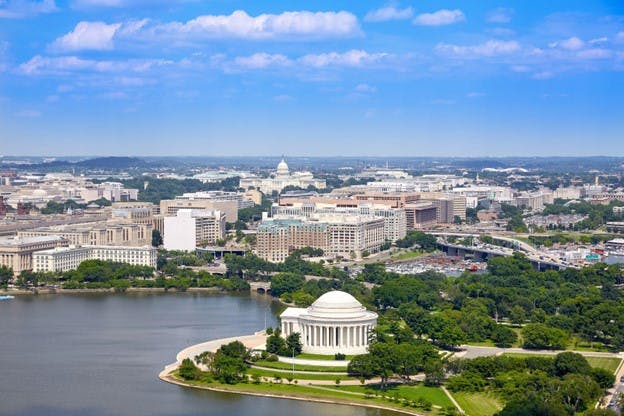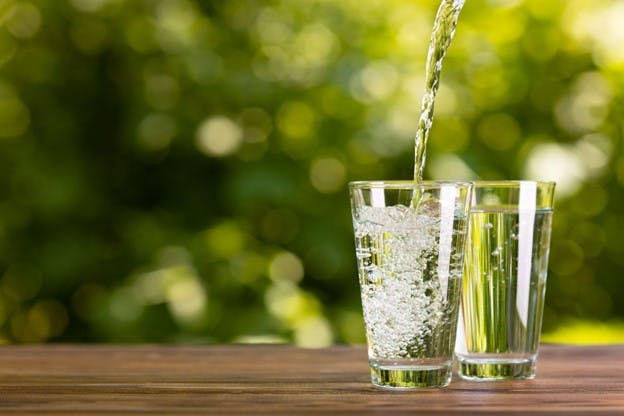September 2023
Capital Concerns? Dive Into Washington, D.C. Water Quality
Although you could fit Washington, D.C. inside Rhode Island over 22 times, few places in the world wield the incredible influence of the nation’s capital. No wonder it attracts so many people for its small size.
Over 700,000 people call Washington, D.C. home. While D.C.’s population is dwarfed by bigger cities like New York City, Los Angeles, Houston, and Chicago, its size makes it nine times more densely populated than New Jersey, the most densely populated state.
That’s a lot of people stacked on top of each other, and that’s just who lives here. It’s estimated that another 20-25 million people visit the nation’s capital annually. With all those people coming and going, it’s of the utmost importance that Washington, D.C. water quality keeps the highest standards.
So how are they doing? In this article we’ll take a look at where Washington gets its drinking water from, who manages it, what challenges they face, and whether or not you should be filtering your D.C. water.
Where Does Washington, D.C. Water Come From?
The District of Columbia gets its water from the 130-mile Potomac River, which runs from the Potomac Highlands to Chesapeake Bay. The river touches four different states and forms part of the border between Maryland and D.C. The river acts as drainage for 14,700 square miles of land and is the watershed for 5 million people.
As the main water source for Washingtonians, the Washington Aqueduct, which is owned by the U.S. Army Corps of Engineers, draws and treats over 140 million gallons of water from the river daily. After going through its water treatment plants, the Washington Aqueduct sells the clean water supply to D.C. Water. D.C. Water distributes the water to homes and businesses throughout the city. D.C. Water is also responsible for wastewater treatment and removal.
Is Washington, D.C. Water Quality Good?
Washington is not just densely populated and highly touristed, it's also a place where shutting down for snow and icy roads can be a challenge. Like most other cities, Washington uses preventative road salt to melt the snow and ice before it freezes to the pavement. However, the amount of salt adds up over the years is causing some problems.
Since a lot of the watershed around the Potomac River is pavement, runoff from the roads into the river has increased the salt in the water 230% in the last 30 years and it’s not stopping. Water utilities will soon need to put hundreds of millions of dollars into desalinating its freshwater.
Salt causes corrosion and environmental damage. It damages cars, the road, and even your water pipes. Damaged water pipes are a real problem because many of them contain lead. While D.C. Water adds chemicals like orthophosphate to lower corrosion of lead pipes and lead service lines, lead exposure through water is a known problem with D.C. tap water.
The corrosion also leads to more debris in the pipes. This debris interacts with the chlorine and chloramines used in drinking water treatment to create disinfection byproducts (DPBs). DPBs can be carcinogenic with enough exposure over time.
Washington also has problems with PFAS, or “forever chemicals.” These are chemicals used in non-stick coatings and water resistant products. The U.S. Environmental Protection Agency (EPA) has been building a case against PFAS for decades.
Across the world these have become a health risk but because they are used in fire fighting foams, groundwater around military bases is often the most heavily contaminated. Washington is no exception.
Needless to say, Washington, D.C. water quality has some room for improvement.
Is It Safe to Drink the Tap Water in Washington, D.C.?
Generally, tap water in Washington, D.C. is considered safe to drink by EPA standards.
As a public health measure, the U.S. EPA creates water quality standards for all water utilities across the United States. These drinking water standards include enforceable limits for 92 substances based on their known health effects and the cost and viability of removing them.
Some contaminants, like microplastics, have been found to be contaminating water supplies around the world, but there are no regulations around them.
Our understanding of the dangers of water contaminants also changes over time. PFAS have been polluting our source water for over 70 years. Almost 25 years ago, we found out they build up in our blood and can cause myriad health problems even in low concentrations. As of 2023, the EPA is finally starting the process of making enforceable regulations for them.
According to D.C.-based water watchdog, the Environmental Working Group (EWG), if the EPA does pass new regulations, it will be the first change made to the water regulations in almost 20 years. This is because our understanding of many contaminants has changed a lot. Many scientists now say the limits allowed by the EPA on several of the regulated pollutants are far too high to maintain public safety.
What Chemicals Are in D.C. Water?
Every year, all public water utilities must release a water quality report (sometimes called a consumer confidence report). The EWG compares the latest recommendations by modern scientists with the concentrations found on these annual reports. Here are the problems the EWG found with Washington, D.C. drinking water quality.
Haloacetic Acids (HAA5)
HAA5 is made up of five haloacetic acids: monochloroacetic acid, dichloroacetic acid, trichloroacetic acid, monobromoacetic acid, and dibromoacetic acid. These chemicals are known as disinfection byproducts, as they result from disinfectants like chlorine interacting with organic matter in water. Long-term exposure to HAA5 can lead to cancer.
Levels of HAA5 in Washington, D.C. water have exceeded what the EWG recommends for safety by 274 times:
- EPA maximum allowance: 60 parts per billion (ppb)
- EWG recommended maximum: 0.1 ppb
- Washington, D.C. maximum contaminant level: 27.4 ppb
Haloacetic Acids (HAA9)
HAA9 includes all of the contaminants from HAA5 but adds bromochloroacetic acid, bromodichloroacetic acid, chlorodibromoacetic acid, and tribromoacetic acid. These are also disinfection byproducts and are also cancer-causing.
Levels of HAA9 in Washington, D.C. water have exceeded what the EWG recommends for safety by 707 times:
- EPA maximum allowance: No legal limit
- EWG recommended maximum: 0.06 ppb
- Washington, D.C. maximum contaminant level: 4.24 ppb
Total Trihalomethanes (TTHMs)
TTHMs — like the haloacetic acids above — are formed when chlorine interacts with organic compounds in drinking water. They’re also known to be carcinogenic. This category is made up of four chemicals: chloroform, bromodichloromethane, dibromochloromethane, and bromoform.
Levels of TTHMs in Washington, D.C. water have exceeded what the EWG recommends for safety by 307 times:
- EPA maximum allowance: 80 ppb
- EWG recommended maximum: 0.15 ppb
- Washington, D.C. maximum contaminant level: 46 ppb
Chromium (Hexavalent)
Chromium is another common contaminant found in U.S. water supplies. It can occur naturally but is also an industrial pollutant. Although it’s known to be a carcinogen, this contaminant is still unregulated by the EPA.
Chromium levels in Washington, D.C. water have exceeded what the EWG recommends for safety by 4.3 times:
- EPA maximum allowance: No legal limit
- EWG recommended maximum: 0.02 ppb
- Washington, D.C. maximum detected level: 0.0863 ppb
Nitrates
Nitrates usually end up in water supplies through stormwater runoff from fertilizers, but they can also come from septic tanks. They can cause oxygen deprivation in infants and increase the risk of certain cancers.
Nitrate levels in Washington, D.C. water have exceeded what the EWG recommends for safety by 13 times:
- EPA maximum allowance: 10 parts per million (ppm)
- EWG recommended maximum: 0.14 ppm
- Washington, D.C. maximum detected level: 1.75 ppm
Arsenic
Arsenic is carcinogenic and is known to cause damage to the brain, central nervous system, skin, and blood vessels. Arsenic is a common contaminant in U.S. public drinking water because it can occur naturally in groundwater.
Arsenic levels in Washington, D.C. water have exceeded what the EWG recommends for safety by 58 times:
- EPA maximum allowance: 10 ppb
- EWG recommended maximum: 0.004 ppb
- Washington, D.C. maximum detected level: 2.33 ppb
Radium
Radium is a radioactive heavy metal found both in nature and as a byproduct of oil and gas production. Radium is a known carcinogen. Legal limits for radium are measured in picocuries per liter (pCi/L), which is a measure of radioactivity.
Radium levels in Washington, D.C. water have exceeded what the EWG recommends for safety by 6.9 times:
- EPA maximum allowance: 5 pCi/L
- EWG recommended maximum: 0.05 pCi/L
- Washington, D.C. maximum detected level: 0.34 pCi/L
Does Washington, D.C. Add Fluoride to City Water?
Yes. As a public health measure, the Washington Aqueduct fluoridates tap water during water treatment. Fluoride is commonly added to drinking water because it is known to strengthen teeth and help prevent dental caries.
While some people welcome the added protection, for many who would rather control their own fluoride use, filtering it out could be an option. It’s important to know that most filters do not remove fluoride. To remove fluoride from water, it's best to use reverse osmosis.
Our HomeWater 4-Stage Reverse Osmosis Under Counter Water Filter easily removes fluoride and so much more.
Does Washington, D.C. Have Hard or Soft Water?
Washington water is considered to be moderately hard but it changes throughout the year. As the months get warmer, the water can be significantly harder than in the colder months.
Water hardness is a measure of dissolved minerals like calcium and magnesium in water. While these minerals are safe to drink, they can be a real nuisance. Hard water minerals clog pipes, damage clothes, wreck appliances, leave soap scum and limescale on your surfaces, and can even cause skin problems like eczema.
If you’re tired of dealing with D.C.’s hard water, consider a water softener or salt-free water conditioner.
Get the Best Quality Water to Your D.C. Home
With over 700,000 people calling the capital city home, Washington, D.C. water quality is really important. While D.C. is considered to have safe drinking water, our review shows many places they could improve.
If you want access to the best-tasting and cleanest water right from your Washington tap, HomeWater can help. Our American-made UPSTREAM 4-Stage Whole Home Water Filter uses multiple filter technologies to remove some of the biggest Washington, D.C. water quality offenders like chloramines, DPBs, microplastics, heavy metals, rust, PFAS, sediment, and more. Add on salt-free water conditioner to get rid of your hard water problems without contributing to D.C. salt problems.



